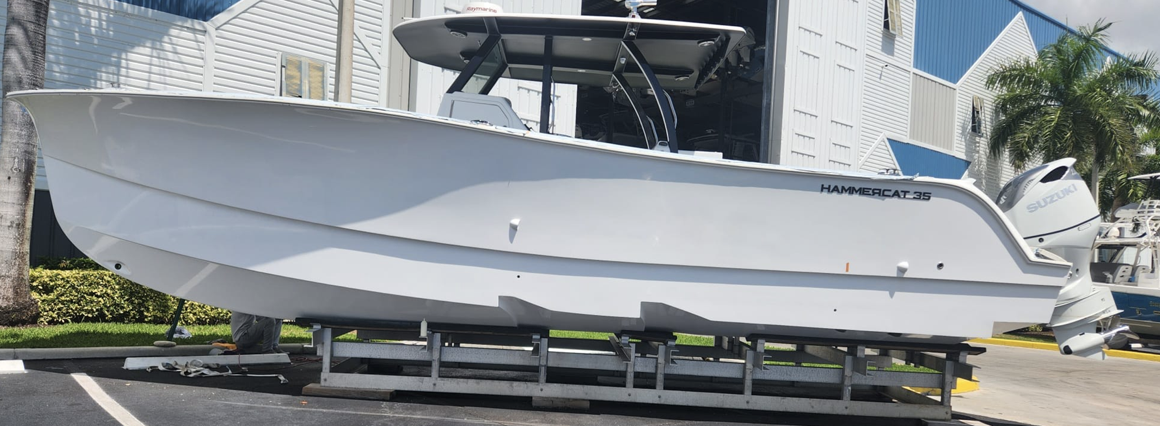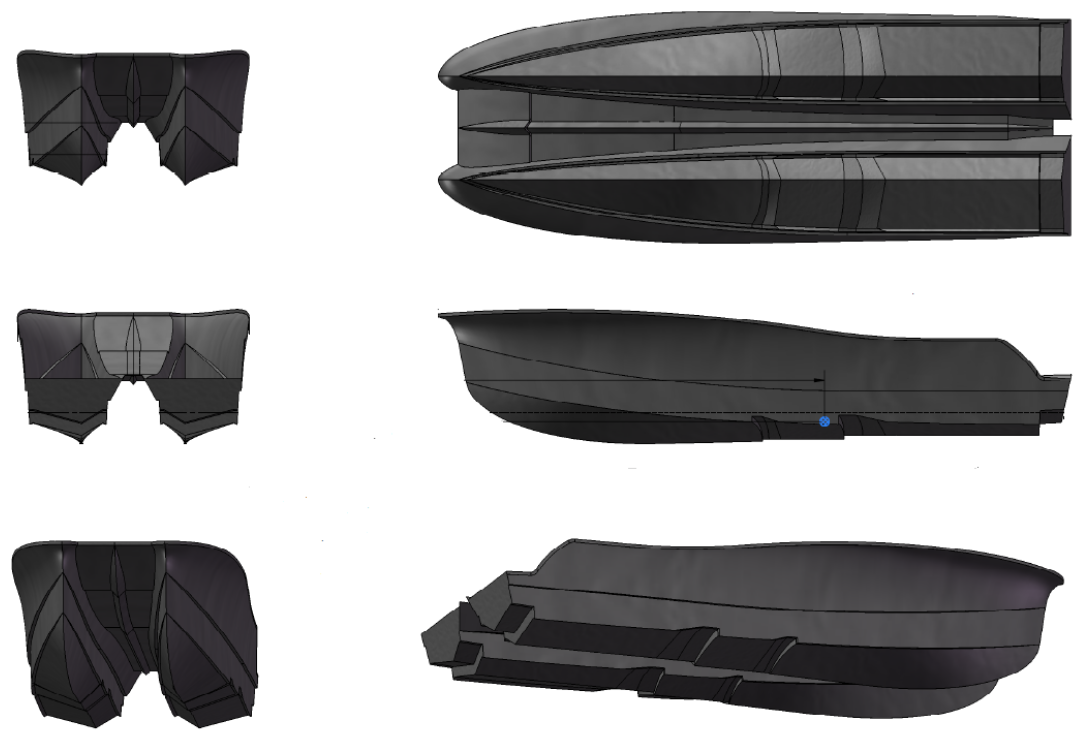Foils or Steps
Fast, Luxurious, Light, and Fuel Efficient.
Foils or Steps
Boat builders have to make many choices during the design and concept stages for a new model.
Most builders don’t even venture into designing a stepped or foiled hull as they don’t have the skills or budget to enter into more complex designs. In the 30’- 45’ center console power-cat range there are 3 choices when it comes to under-water design for planing power-catamarans:
- a regular non-stepped hull
- a stepped hull / double stepped hull or
- a foil (or foils)
- A regular non-stepped hull is, well, there is not much to say about it. The original power catamarans that were built in the 80ies, 90ies and 2000s all had a symmetric or asymmetric hull without steps. At the time there was not much product
or hull development going on, and the power-cats themselves were already exciting enough that not much attention was paid to what happened underwater / under the hull.
Advantages: easy to build, easy to design.
Disadvantages: old-fashioned, nothing exciting
- A double stepped hull: Hammer Yachts opted for double stepped hulls for all the models (HammerCat 30-35-45) as this is the most versatile in offshore conditions and offers the best dynamics between comfort, efficiency and speed. A stepped
hull reduces the wet surface, and lowers drag.
Advantage: comfortable ride, better fuel economy, and due to synergy between the hull and topside design, also a dryer ride. A stepped hull has higher speed potential, the aerated hull moves faster through the water.
Disadvantages: complex design, more complicated to build, more expensive to build.
- A hull with foil(s) has either one or two (static) foils. This is what is called “displacement foiling”: when 'x' amount of lift is created at different speeds, the hull pops up out of the water, it does not lift the hull out the water,
it is more like “shallow foiling”. It is fast and efficient; but has to operate in its designed window. The deeper the foil(s) the rougher the sea state it can handle, but there's a limit as you also have to think about your draft.
Advantages: excellent fuel efficiency at higher speeds
Disadvantages: static foils are designed for a certain “bandwidth (window) of conditions”: if the conditions are different than what the foils are designed for, the foils can work against each other.
- A regular non-stepped hull is, well, there is not much to say about it. The original power catamarans that were built in the 80ies, 90ies and 2000s all had a symmetric or asymmetric hull without steps. At the time there was not much product
or hull development going on, and the power-cats themselves were already exciting enough that not much attention was paid to what happened underwater / under the hull.

The double stepped hull on the HammerCat 35
HammerCat hulls feature a "double step", which achieves the same, or actual, better results compared to a foil.
Foils work mostly / only in flat water, and in certain conditions. If there is a short chop, part of the hull and part of the foil can be in the water / out of the water and the boat does not know if it wants to go up on the foils, or down as there is not enough lift. Dynamic foils that balance the boat fore and aft would solve this, but those are only seen on racing sailing catamarans or high-end power-catamaran ferries. You need lots of expensive hardware, software, and a team of engineers to run your boat. This technology for cruising boats is still many years away.
Foiled power-catamarans have either one or two appendixes (foils) sticking out from the hulls, inside the tunnel, with the potential of grabbing lobster pots, seaweed, debris or worse, a high impact with a solid object forcing the foil to separate from the hull.
Foils work perfectly well running in the ICW or in flat water. Foils are static, that means the naval architect designed them for a certain window of conditions. If the conditions change (wave height, wave period, load of the boat, distribution of the load, windage etc.), then the dynamics of the foils stay the same. Compare this to going off-roading and not being able to adapt your 4WD to different settings.
The double stepped hull of the HammerCat 30-35-45 pulls in “air” from the steps in the side and directs it under the stern of the boat so the boat rides on a cushion of "aerated water", and the hull actually “pops up” out of the water, helped by the powerful dynamics of aerated water.
- Speed: Steps reduce frictional drag on the water, making stepped hull boats 15% faster than non-stepped / standard hulls. Stepped hulls distribute lift evenly, keeping the HammerCat level at higher speeds and maintaining a consistent trim angle. They often give you a smoother ride and can make it easier to maintain top speeds.
- Efficiency: When you reduce friction and drag, your vessel becomes more efficient. As your boat requires less power to move across the water at high speeds, it uses less fuel, making it more cost-effective to run and reducing emissions.
- Built-in trim: A stepped hull boat design automatically runs at an optimal trim angle, eliminating the need to adjust the trim with outboards, drives or trim tabs.
- Comfort: The reduced friction a stepped hull provides can make your ride more comfortable, improving the handling and providing a softer landing at high speeds. As you’re almost gliding across the water, you can enjoy reduced pitch, slamming and spray.
- Visibility: The consistent plane you achieve in a stepped hull boat reduces spray and improves your visibility on the water
- Holeshot: The term “holeshot” refers to a boat’s initial acceleration from a stationary point. A well-designed stepped hull improves the holeshot experience, streamlining the bow rise and keeping the experience smooth.
Thus, a very soft ride is assured in any conditions.
Conclusion:
At Hammer Yachts we feel a double stepped hull offers better performance all around, and in all conditions.
As always, the proof is in the pudding: do a sea-trial on the different power-catamarans you are considering, and make sure the conditions during your sea-trial are challenging. All boats ride well in flat water, and only in rougher conditions can you truly experience the ride. Once you have tried and tested other power-catamarans, you will come to the same conclusion as many others:
"There is not softer riding cat than a HammerCat"
Illustrations:


The steps pull in air under the hull, where the air mixes with water, and the inward curves hold the aerated water under the hulls,
ensuring a soft ride in any conditions.

